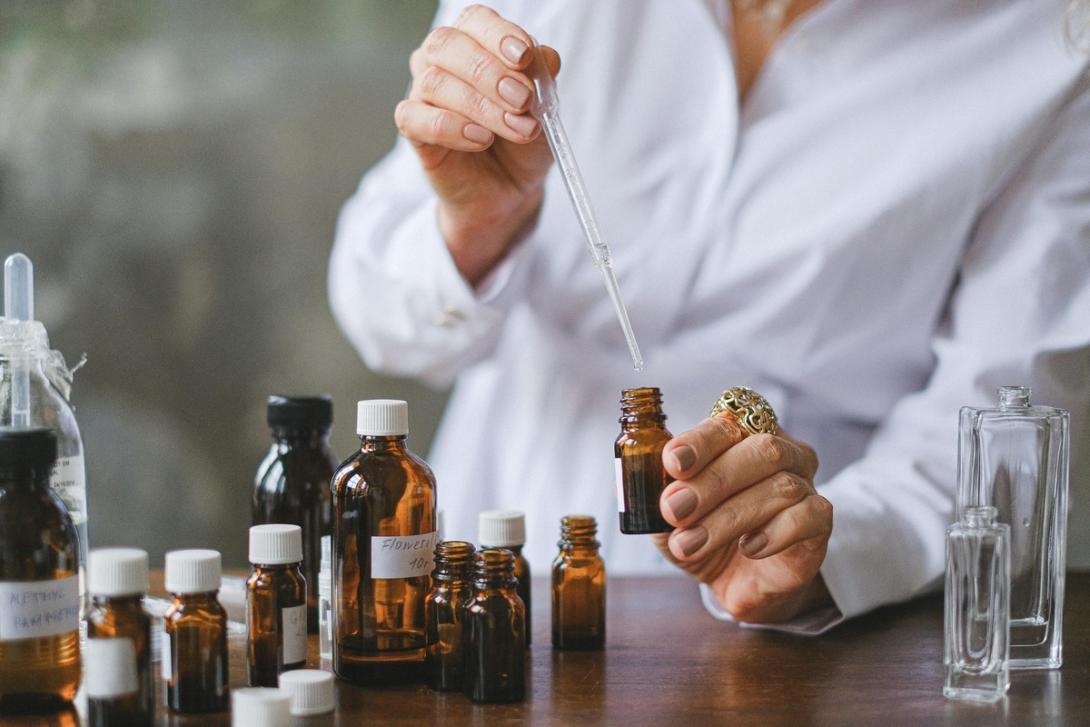
ABSTRACT
This study assesses the antioxidant, antibacterial, and physico-chemical characteristics of five essential oils from two distinct brands in Pakistan. Greater antibacterial efficiency against tested pathogens and superior antioxidant activity, as assessed by the DPPH assay, were consistently displayed by Brand A, indicating larger amounts of active components such as flavonoids and phenolics. Significant antioxidant activity was shown by Butylated hydroxyanisole (BHA) at 1.56 μg/ml and Butylated hydroxytoluene (BHT) at 0.73 μg/ml; clove oil, on the other hand, exhibited even more effective antioxidant action, with IC50 values of 0.360 mg/mL and 0.03 mg/mL, which were attributed to their high eugenol concentration.
This work unifies earlier fragmented research on the physico-chemical, antioxidant, and antibacterial characteristics of essential oils, offering a thorough study and emphasizing the notable variation within brands. The results highlight how crucial rigorous quality control and standardized testing are to ensuring therapeutic efficacy and consistency in essential oil production. Subsequent investigations ought to broaden the scope of essential oils and brands scrutinized, incorporate in vivo evaluations, and investigate the influence of extraction techniques and environmental elements on the bioactivity of essential oils. A deeper comprehension of these facets may result in the creation of standardized essential oil products with clear therapeutic uses, supporting complementary and alternative medical procedures.
1. Introduction:
Essential Oils (EOs) are highly complex natural mixtures of low-molecular mass volatile molecules such as terpenes and aldehydes, responsible for the typical aroma of aromatic plants (APs). Several EOs and metabolites in plant extracts are accepted as "Generally Recognized as Safe" (GRAS). Aromatic plants (APs) have been used since ancient times in traditional medical treatments and as food preservatives since they contain many biologically active components, including phenolic compounds (e.g., phenolic acids, flavonoids, coumarins, lignans, stilbenes, and tannins), substances with nitrogen (alkaloids, amines, and betalains), and terpenoids, including carotenoids (Mutlu-Ingok et al., 2020).
They are widely utilized as food preservatives, medicines, fragrances, and cosmetics in many different nations. Because of their flavor and scent, they were first employed as remedies in the 19th century. Approximately 300 of the 3000 EOs that have been found to date are employed in perfumery because of their strong fragrance. One of the central focuses of this research is to scrutinize the accuracy of claims such as "100% pure" often made by essential oil manufacturers. Such claims imply that the oils are entirely natural, unadulterated, and free from synthetic additives or impurities. However, without rigorous scientific evaluation, these claims may not always hold true. By conducting detailed analyses of critical parameters such as biological activity, antioxidant capacity, and physico-chemical properties, this research seeks to provide empirical evidence regarding the actual purity and quality of essential oils from different brands.
Through this analysis, valuable insights can be gained into the accuracy of claims made by manufacturers regarding the purity and quality of their essential oils. Additionally, by highlighting any discrepancies between claimed purity and actual quality, this research can promote better industry practices. It can encourage essential oil manufacturers to adhere to higher standards of quality control, sourcing, and production processes, ensuring consistent quality and safety for consumers.
1.1 Research Objectives of the Study:
The current study's overall objectives were the following:
- To examine antioxidant activity, antimicrobial activity, and different biological activity between two different locally available brands of essential oils.
- To examine physico-chemical properties of essential oils between two brands.
1.2 Significance of the Study:
By conducting detailed analyses of critical parameters such as antimicrobial activity, antioxidant capacity, and physico-chemical properties, this research seeks to provide empirical evidence regarding the actual purity and quality of essential oils from different brands. Through this analysis, valuable insights can be gained into the accuracy of claims made by manufacturers regarding the purity and quality of their essential oils.
1.3 Definition of Key Terms:
Antioxidant activity:
The ability of a substance to prevent or slow down the oxidation process, protecting cells from damage caused by free radicals.
Antimicrobial activity:
The ability of a substance to kill or inhibit the growth of microorganisms, including bacteria, fungi, and viruses.
Contamination:
The presence of unwanted substances or impurities in a product, which can affect its quality and safety.
Physico-chemical properties:
The physical and chemical characteristics that define the behavior and composition of essential oils, crucial for understanding the quality, efficacy, and applications of essential oils in various fields such as aromatherapy, pharmaceuticals, and cosmetics.
2. Methodology
The study employs an experimental research design to assess and compare the physico-chemical characteristics, antioxidant, and antibacterial activities of essential oils from two distinct brands sold in Pakistan. The study employs a quantitative methodology to assess and compare the chosen essential oils' qualities in an objective manner. Five essential oils were selected from two brands (Brand A and Brand B). The essential oils chosen for this study include lavender, clove, tea tree, peppermint, and eucalyptus. These oils were selected based on their widespread use and reported biological activities.
Data Collection Procedure:
- Physico-chemical analysis: Conducted by UV-vis spectroscopy to observe any color differences in essential oils.
- Antioxidant activity: Assessed using the DPPH (2,2-diphenyl-1-picrylhydrazyl) free radical scavenging assay, measuring the absorbance at 517 nm after a 30-minute incubation period in the dark.
- Antibacterial activity: Evaluated against selected bacterial strains (e.g., S. aureus and P. aeruginosa).
Data were analyzed using statistical software (e.g., SigmaPlot) and descriptive statistics (mean, standard deviation) were calculated for physico-chemical properties, antioxidant, and antibacterial activities. Results were presented using tables, bar charts, and graphs to visually compare the antioxidant and antibacterial activities of the essential oils from the two brands.
3. Results and Discussion:
This study assessed the physico-chemical characteristics, antioxidant and antibacterial activities of five distinct essential oils from two brands. When compared, the essential oils from Brand A generally showed stronger antioxidant activity, based on the DPPH assay (Chen et al., 2023). Similarly, when tested against the strains under evaluation, Brand A's essential oils showed greater antibacterial activity. The results suggest that clove and tea tree oils met the antimicrobial efficacy expected from their pure forms, while the other oils did not show significant antimicrobial activity. No activity might indicate possible adulteration or low concentrations of active compounds.
The higher levels of antioxidant activity found in the essential oils of Brand A imply that these oils have greater quantities of active ingredients like flavonoids and phenolics. To compare our antioxidant activity, we took two antioxidants as our controls: Butylated hydroxyanisole (BHA) and Butylated hydroxytoluene (BHT). According to the DPPH assay, the controls showed significant antioxidant activity; Butylated hydroxyanisole (BHA) at 1.56 μg/ml and Butylated hydroxytoluene (BHT) at 0.73 μg/ml. Clove oil has an IC50 value of 0.360 mg/mL and 0.03 mg/mL, suggesting very potent antioxidant action. This is significantly less than the value from other oils and much less than the IC50 value of BHA and BHT antioxidants. Thus, compared to other tested oils and the BHA and BHT antioxidants, clove oil exhibits noticeably stronger antioxidant activity, with an IC50 value of 0.360 mg/mL and 0.03 mg/mL from both companies. Eugenol, a strong phenolic component found in clove oil, is largely responsible for the oil's well-known antioxidant qualities.
If “100% pure” essential oils show low or high antioxidant activity, it could mean they are impure or adulterated. Different essential oils showed distinct absorbance patterns in the UV-Vis spectrum. The UV-Vis spectra of various essential oils (clove, lavender, eucalyptus, rosemary, and tea tree) were measured in the wavelength range of 190-800 nm. The spectra were plotted with absorbance on the y-axis and wavelength on the x-axis. All oils exhibited broad absorbance in the 300-400 nm range, with notable variations among different brands. For clove oil, the UV-Vis spectrum revealed a prominent absorbance peak at 390 nm for Company 1, while Company 2’s clove oil showed a peak at 395 nm. Eucalyptus oil from Company 1 displayed a peak at 390 nm, whereas Company 2's eucalyptus oil had a peak at 340 nm. Lavender oil from Company 1 (Brand A) exhibited a peak absorbance at 390 nm, in contrast to Company 2's lavender oil, which had a peak at 400 nm. Rosemary oil showed peaks in the range of 390-397 nm for both Company 1 and 2. Tea tree oil presented a steep absorbance curve from approximately 200 nm to 350 nm, with the maximum peak occurring at 300 nm for Company 1 and at 310 nm for Company 2.
The variation in UV-Vis Spectra indicates that the oils are not entirely pure or contain additional components not declared by the manufacturer. Absorbance in the UV range (200-400 nm) typically corresponds to the presence of phenolic compounds and other UV-absorbing substances. Absorbance in the visible range (400-700 nm) is directly related to the color perceived by the human eye. Previous studies conducted in Pakistan have looked into the physico-chemical, antioxidant, and antibacterial qualities of several essential oils. Still, these researches usually concentrated on particular elements or particular essential oils. Our research attempted to combine these elements into a single thorough analysis, assessing the distinct qualities as well as comparing the identical essential oils from various vendors.
3.1 Limitations of the Study:
- Sample Size: The study evaluated only five distinct essential oils from two brands. This small sample size may not be representative of the entire market, limiting the generalizability of the findings.
- In Vitro Limitations: The research was confined to in vitro experiments. While these tests provide valuable insights into the antioxidant and antibacterial activities of essential oils, they do not fully replicate the complex interactions and effects that occur in vivo within a living organism.
- Regional Scope: The study mainly focused on essential oils available in Karachi, which may not reflect the properties of similar essential oils from other regions. Including essential oils produced in other parts of Pakistan or other countries could provide a more comprehensive understanding.
- Bacterial Strain Specificity: The antibacterial activity was tested against specific strains of bacteria. The results might differ with other bacterial strains, limiting the scope of the findings.
4. Conclusion:
The biological activity and physico-chemical characteristics of two commercially available brands of essential oils (EOs) in Pakistan were examined in this study. The results showed differences in the two brands' antibacterial, antioxidant, and physico-chemical qualities, suggesting possible disparities in quality across the market. These findings highlight the necessity of more stringent quality control procedures to guarantee EOs' constant purity and effectiveness.
This study shows the potential of EOs as natural sources of bioactive chemicals with antibacterial and antioxidant qualities, despite its limitations. A deeper understanding of the chemical composition-activity relationship of essential oils can be obtained by expanded study with a wider scope, encompassing a greater range of brands and analysis employing cutting-edge techniques like GC-MS. The creation of standardized essential oil products with clearly defined therapeutic applications may be facilitated by this knowledge. Essential oils have the potential to be beneficial supplements to complementary and alternative medicine practices with further research and quality control measures.


